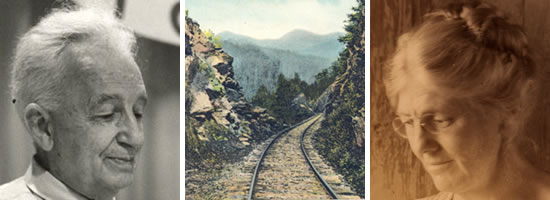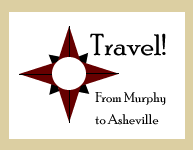A Region Defined:
Taking the Train
In an article written about handcraft, author Allen Eaton remarked that he met folk school founder Olive Dame Campbell at a train station in New York. Both of them had finished up meetings at the Russell Sage Foundation, a philanthropic foundation that contributed to “mountain work” in the southern highlands. Campbell was catching a train to Washington DC where she would make a connection to Asheville, a destination spot nestled in the mountains of western North Carolina.

Take the train to follow Allen Eaton (left) and Olive Campbell (right)
on their trip to western North Carolina.
Once in Asheville, Campbell took the Southern Railway to reach her destination, a folk school in Brasstown. From Asheville, the Southern Railway route roughly lay along today’s interstate 40. In Waynesville, where today’s I-40 cuts north toward Knoxville, the railway’s Murphy Branch continued west over Balsam mountain with stops in Sylva, Dillsboro, and Whittier before it cut south through the Nantahala Gorge. The final North Carolina destination was Murphy. There, Olive Campbell got off the train and was no doubt met by someone who would take her to Brasstown and the John C. Campbell Folk School. Follow Olive Campbell’s route from Asheville to Murphy: take a ride on the train.
In the earliest decades of the Craft Revival, rough terrain made overland travel difficult. To reach the deepest mountain covers, travelers came by wagon. When the rutted path got rough, travelers switched to horseback or continued on foot. For longer trips, people traveled to and from the region by train. Lucy Morgan, founder of the Penland School of Handicrafts, arrived as a young woman in 1920 to teach at the Episcopal Appalachian School. The community of Penland was small, even by 1920s standards, but it was served by the Clinchfield Railway. “If you look sharply, from here,” she wrote, “you can see a church and three houses. But in the wintertime with the leaves off the trees you can see five houses.” 1
Morgan vividly describes her arrival at the Penland train station in 1920 in her memoir Gift from the Hills.
“The whistle tooted, the smokestack belched a round puff of white steam and black smoke, the little locomotive groaned, gasped, lunged and fell back, strained and went forward, and with much bell ringing, the drive wheels clutching at rails, and accelerated puffing, began to catch speed. And there we stood, our valises at our feet.”
See More: Take a ride on the train as it was in the 1910s
1. Lucy Morgan and LeGette Blythe. Gift from the Hills (Chapel Hill: University of North Carolina Press, 1958), 3-4.




